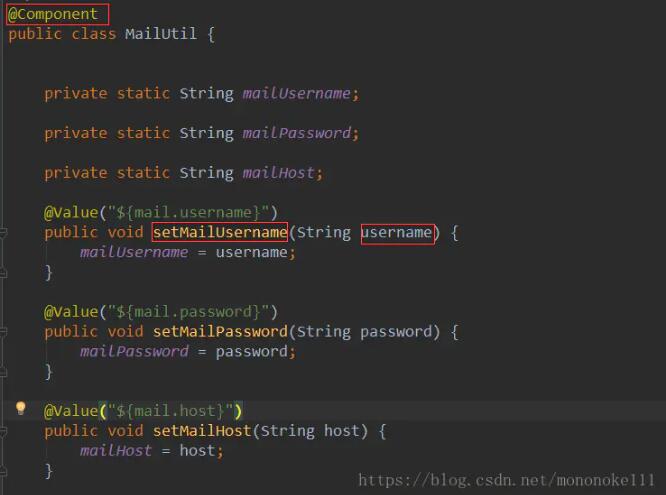Springboot 讀取自定義pro文件注入static靜態(tài)變量方式
mailConfig.properties
#服務(wù)器mail.host=smtp.qq.com#端口號mail.port=587#郵箱賬號mail.userName=hzy_daybreak_lc@foxmail.com#郵箱授權(quán)碼mail.passWord=vxbkycyjkceocbdc#時間延遲mail.timeout=25000#發(fā)送人mail.emailForm=hzy_daybreak_lc@foxmail.com#發(fā)件人mail.personal=華夏衣裳#主題mail.subject=同袍用戶激活#內(nèi)容模板mail.html=您的郵箱驗證碼為:
MailConfig.java
/* * @(#)MailConfig.java Created on 2019年9月11日 * Copyright (c) 2019 ZDSoft Networks, Inc. All rights reserved. * $Id$ */package com.hxyc.config.properties; import org.springframework.beans.factory.annotation.Value;import org.springframework.context.annotation.Configuration;import org.springframework.context.annotation.PropertySource;import org.springframework.stereotype.Component; /** * @author huangzy * @version $Revision: 1.0 $, $Date: 2019年9月11日 上午10:29:35 $ */@Configuration@PropertySource(value = 'classpath:config/mailConfig.properties', encoding = 'UTF-8')@Componentpublic class MailConfig { public static String host; public static Integer port; public static String userName; public static String passWord; public static String emailForm; public static String timeout; public static String personal; public static String html; public static String subject; /** * @return Returns the host. */ public static String getHost() {return host; } /** * @param host * The host to set. */ @Value('${mail.host}') public void setHost(String host) {MailConfig.host = host; } /** * @return Returns the port. */ public static Integer getPort() {return port; } /** * @param port * The port to set. */ @Value('${mail.port}') public void setPort(Integer port) {MailConfig.port = port; } /** * @return Returns the userName. */ public static String getUserName() {return userName; } /** * @param userName * The userName to set. */ @Value('${mail.userName}') public void setUserName(String userName) {MailConfig.userName = userName; } /** * @return Returns the passWord. */ public static String getPassWord() {return passWord; } /** * @param passWord * The passWord to set. */ @Value('${mail.passWord}') public void setPassWord(String passWord) {MailConfig.passWord = passWord; } /** * @return Returns the emailForm. */ public static String getEmailForm() {return emailForm; } /** * @param emailForm * The emailForm to set. */ @Value('${mail.emailForm}') public void setEmailForm(String emailForm) {MailConfig.emailForm = emailForm; } /** * @return Returns the timeout. */ public static String getTimeout() {return timeout; } /** * @param timeout * The timeout to set. */ @Value('${mail.timeout}') public void setTimeout(String timeout) {MailConfig.timeout = timeout; } /** * @return Returns the personal. */ public static String getPersonal() {return personal; } /** * @param personal * The personal to set. */ @Value('${mail.personal}') public void setPersonal(String personal) {MailConfig.personal = personal; } /** * @return Returns the html. */ public static String getHtml() {return html; } /** * @param html * The html to set. */ @Value('${mail.html}') public void setHtml(String html) {MailConfig.html = html; } /** * @return Returns the subject. */ public static String getSubject() {return subject; } /** * @param subject * The subject to set. */ @Value('${mail.subject}') public void setSubject(String subject) {MailConfig.subject = subject; } }springboot靜態(tài)屬性注入的解決第一種方式
通過springboot組件初始化生命周期進行屬性(對象)賦值
@Componentpublic class DSHWechatApiUtil extends DSHBaseController { @Autowired private IThirdPartyAuthDao thirdPartyAuthDao; private static IThirdPartyAuthDao staticThirdPartyAuthDao;@PostConstruct public void init() {staticThirdPartyAuthDao = thirdPartyAuthDao; } public static JSONObject getAuthorizerToken(String componentAccessToken, String authorizerAppid, String authorizerRefreshToken) {JSONObject returnObject = new JSONObject();try { if (DSHUtils.isEmpty(componentAccessToken)) {componentAccessToken = staticThirdPartyAuthDao.selectWechatValue(DSHConstants.WECHAT_PARAMS.COMPONENT_ACCESS_TOKEN); }} catch (Exception e) { e.printStackTrace();}return returnObject; }}
可以看到,當(dāng)DSHWechatApiUtil工具類組件進行初始化時,調(diào)用@PostConstruct注解標(biāo)注的方法,對靜態(tài)變量進行了賦值。
第二種方式通過@Value()注解
@Value()注解不會對靜態(tài)變量進行屬性注入,通過第一種方式的思維,那么我們肯定得想個辦法,在這個組件初始化時也來賦值。
第一種方式肯定也是可以的,先寫一個屬性,然后通過@Value()注解對這個屬性進行賦值,最后通過@PostConstruct注解方式賦值給靜態(tài)屬性。
這里我們要采用另一個方式,這里的方式是通過set方法來賦值。屬性是static修飾的,get方法也是static修飾的,但是set方法不能是static修飾,使用@Value()注解來修飾set方法。

這樣就能成功注入。
第三種方式第三種方式和第二種差不多,
@ConfigurationProperties(prefix = ProjectConfig.PROJECT_PREFIX)public class ProjectConfig { public static final String PROJECT_PREFIX = 'project'; /** * 系統(tǒng)版本號 */ private String version; /** * 項目名稱 */ private String name; /** * 版權(quán)年份 */ private String copyrightYear; /** * 實例演示開關(guān) */ private static boolean demoEnabled; /** * 獲取地址ip開關(guān) */ private static boolean addressEnabled; public String getVersion() {return version; } public void setVersion(String version) {this.version = version; } public String getName() {return name; } public void setName(String name) {this.name = name; } public String getCopyrightYear() {return copyrightYear; } public void setCopyrightYear(String copyrightYear) {this.copyrightYear = copyrightYear; } public boolean isDemoEnabled() {return demoEnabled; } public void setDemoEnabled(boolean demoEnabled) {ProjectConfig.demoEnabled = demoEnabled; } public static boolean isAddressEnabled() {return addressEnabled; } public void setAddressEnabled(boolean addressEnabled) {ProjectConfig.addressEnabled = addressEnabled; }}
如上述代碼,只要把set方法設(shè)置為非靜態(tài),那么這個配置類的靜態(tài)屬性就能成功注入了。
以上為個人經(jīng)驗,希望能給大家一個參考,也希望大家多多支持好吧啦網(wǎng)。
相關(guān)文章:
1. Python實現(xiàn)迪杰斯特拉算法過程解析2. JavaScript Reduce使用詳解3. 淺談JavaScript中等號、雙等號、 三等號的區(qū)別4. Spring security 自定義過濾器實現(xiàn)Json參數(shù)傳遞并兼容表單參數(shù)(實例代碼)5. 詳解Python模塊化編程與裝飾器6. python使用ctypes庫調(diào)用DLL動態(tài)鏈接庫7. Python如何進行時間處理8. python裝飾器三種裝飾模式的簡單分析9. JavaScript中的AOP編程的基本實現(xiàn)10. 詳解java中static關(guān)鍵詞的作用

 網(wǎng)公網(wǎng)安備
網(wǎng)公網(wǎng)安備